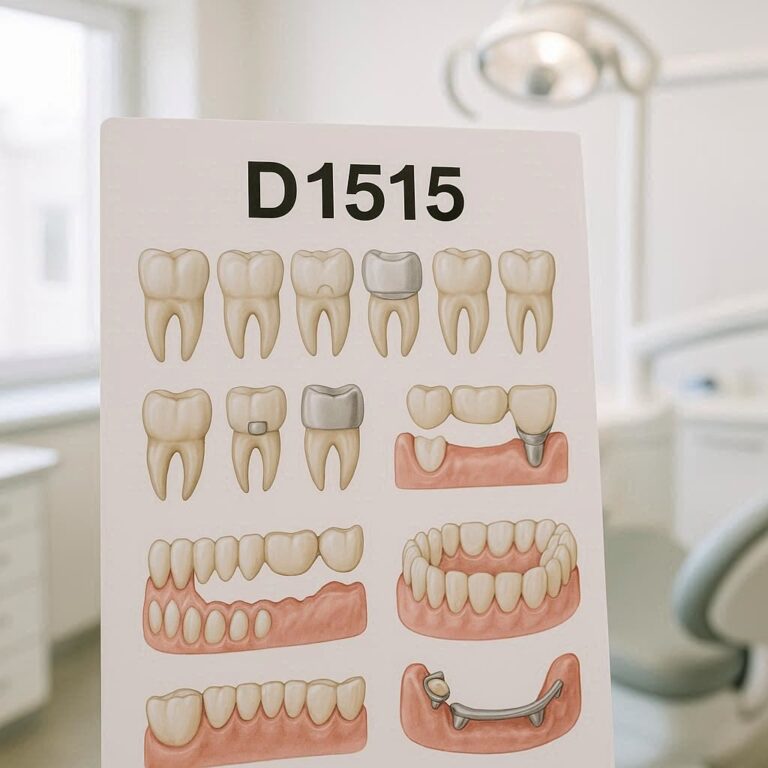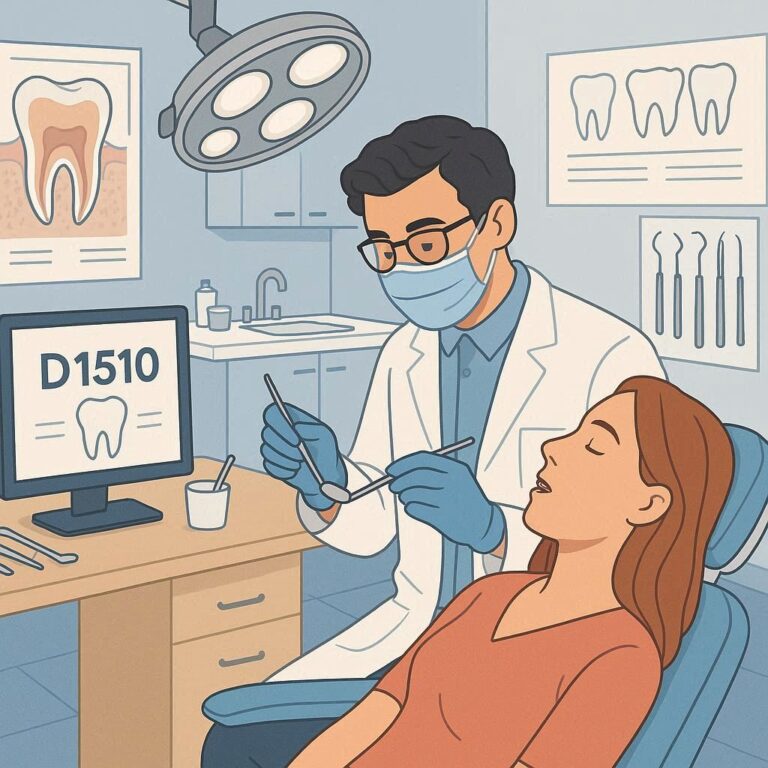d1110 dental code
Dental procedures are categorized and standardized using specific codes that ensure consistency in billing, insurance claims, and patient records. One such code, D1110, is integral to routine dental care. This article delves deep into the D1110 dental code, exploring its definition, application, cost, and significance in the broader field of dentistry.

What is Dental Code D1110?
Definition of D1110
D1110 is a dental code used in the Current Dental Terminology (CDT) system to classify and describe a specific dental procedure. This code is primarily associated with a prophylaxis treatment, commonly referred to as a “dental cleaning” for adults.
Historical Background of the D1110 Code
The D1110 code has evolved over the years, reflecting changes in dental practices and insurance requirements. Originally introduced as a part of a broader effort to standardize dental care across the United States, the D1110 code has been updated periodically to align with advances in dental technology and patient care protocols.
D1110 Dental Code Definition
Explanation of the Code in Dental Billing Systems
The D1110 code represents “Prophylaxis – Adult,” which involves cleaning the teeth to prevent cavities, gingivitis, and other oral health issues. It is typically used for patients over the age of 14 and is considered a preventive measure in dental care.
Importance of Accurate Coding in Dentistry
Accurate coding is crucial in dentistry for several reasons, including insurance reimbursement, patient records, and legal compliance. The D1110 code helps ensure that patients receive appropriate care and that providers are compensated correctly.
D1110 Dental Code Description
Detailed Description of the Procedure
The procedure covered by the D1110 code involves the removal of plaque, calculus (tartar), and stains from the tooth structures in permanent and transitional dentition. This procedure is typically performed by a dental hygienist and may include polishing the teeth to smooth the enamel and remove superficial stains.
Clinical Indications for D1110
D1110 is indicated for adult patients with healthy gum tissue or mild gingivitis. It is not suitable for patients with periodontal disease, who may require more intensive cleaning procedures, coded differently under the CDT system.
Steps Involved in the Procedure
- Initial Examination: The dental professional evaluates the patient’s oral health to determine the need for prophylaxis.
- Scaling: Removal of plaque and tartar using hand instruments or ultrasonic scalers.
- Polishing: Smoothing the tooth surfaces with a prophylactic paste to remove superficial stains.
- Fluoride Treatment (Optional): Application of fluoride to strengthen the enamel and prevent decay.
Best Practices for Dental Hygienists
Dental hygienists performing the D1110 procedure should follow strict protocols to ensure patient safety and the effectiveness of the treatment. This includes using sterilized instruments, proper patient positioning, and thorough documentation of the procedure.
Dental Procedure Code D1110
How D1110 Fits into the CDT (Current Dental Terminology)
D1110 is a part of the preventive category in the CDT, a coding system developed by the American Dental Association (ADA) to standardize the description of dental procedures. It is one of the most commonly used codes in dental practices due to the routine nature of adult dental cleanings.
Differences Between D1110 and Similar Codes
While D1110 covers prophylaxis for adults, other similar codes include D1120 for child prophylaxis and D4910 for periodontal maintenance. Understanding these differences is essential for accurate billing and patient care.
Application of D1110 in Various Dental Practices
D1110 is used across different types of dental practices, including general dentistry, pediatric dentistry, and periodontal clinics. Its application may vary slightly depending on the specific needs of the patient population.
D1110 Dental Code Cost
Average Cost of a D1110 Procedure
The cost of a D1110 procedure can vary widely depending on geographic location, the specific dental practice, and whether the patient has insurance coverage. On average, the cost ranges from $75 to $200 per cleaning.
Factors Influencing the Cost
Several factors can influence the cost of a D1110 procedure, including:
- Location: Urban areas tend to have higher costs due to increased overhead.
- Dental Practice: Practices with advanced technology or higher-end facilities may charge more.
- Patient’s Oral Health: Additional treatments or a higher frequency of cleanings may increase the overall cost.
Geographic Variation in Pricing
Geographic location plays a significant role in the pricing of dental services. For instance, dental cleanings in metropolitan areas like New York or Los Angeles may be more expensive compared to smaller towns or rural areas.
Insurance Coverage and Out-of-Pocket Expenses
Most dental insurance plans cover prophylaxis under the D1110 code, often fully or with a small co-payment. However, patients without insurance may face higher out-of-pocket costs, which can vary depending on the practice.
D1110 Dental Code Age
Age Specifications for the D1110 Procedure
The D1110 code is designated for patients aged 14 and older. For younger patients, the D1120 code is typically used, reflecting the different dental needs and care approaches for children.
Pediatric vs. Adult Applications of D1110
While D1110 is specifically for adults, it’s important to understand the transition from child to adult prophylaxis. The timing of this transition can depend on the patient’s oral health, development, and specific needs.
Guidelines for Older Adults
Older adults may require more frequent use of the D1110 code due to increased risk factors such as gum disease, dry mouth, and other age-related oral health issues. Dental practices should tailor their approach to meet the unique needs of this demographic.
Dental Billing Code D1110
Billing Procedures and Requirements
Correct billing using the D1110 code involves detailed documentation of the procedure, patient consent, and accurate submission to insurance companies. Dental practices must ensure that all billing codes align with the services provided to avoid claims denials.
Common Errors and How to Avoid Them
Common billing errors with the D1110 code include incorrect patient age coding, failure to document the procedure properly, and using the wrong code for the patient’s condition. Training and regular audits can help avoid these errors.
Tips for Dental Practices in Using D1110
Dental practices can optimize their use of the D1110 code by staying updated on coding changes, providing staff training, and using software that integrates coding with electronic health records (EHRs).
Integration with Electronic Health Records (EHRs)
EHRs can streamline the billing process by automatically suggesting the correct codes based on the procedures performed. This integration reduces the likelihood of human error and speeds up the claims process.
Conclusion
The D1110 dental code is an essential component of routine dental care, particularly in the prevention of oral health issues in adults. Its correct application and billing are vital for ensuring both patient care and the financial health of dental practices.
FAQs
- What is the D1110 dental code?
- D1110 is the code for a prophylaxis procedure for adults, commonly known as a dental cleaning.
- How often should D1110 be used?
- Typically, D1110 is used twice a year for routine cleanings, but frequency may vary based on the patient’s oral health.
- Is D1110 covered by insurance?
- Most dental insurance plans cover the D1110 procedure as part of preventive care.
- Can D1110 be used for children?
- No, the D1120 code is used for children’s prophylaxis. D1110 is designated for patients aged 14 and older.
- What factors affect the cost of a D1110 procedure?
- Factors include location, the dental practice, the patient’s oral health, and insurance coverage.


